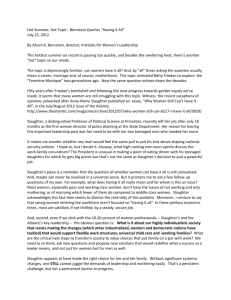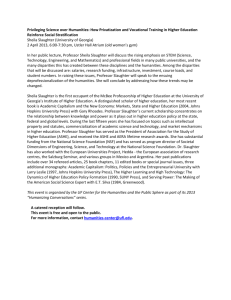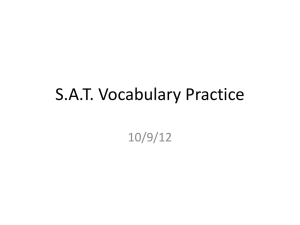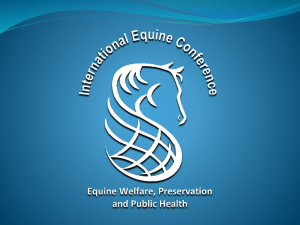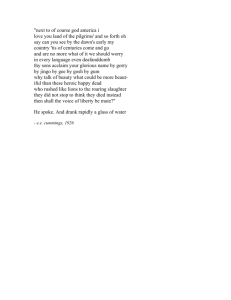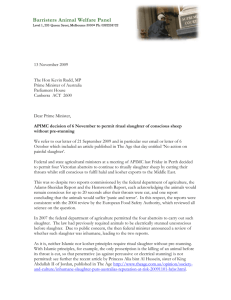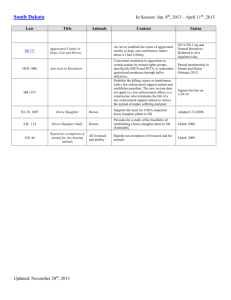Halal Slaughter - Halal Research Council
advertisement
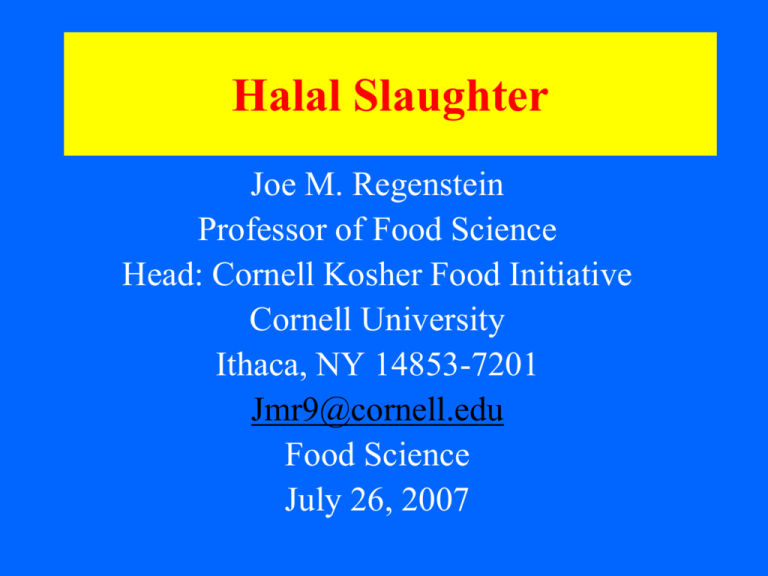
Halal Slaughter Joe M. Regenstein Professor of Food Science Head: Cornell Kosher Food Initiative Cornell University Ithaca, NY 14853-7201 Jmr9@cornell.edu Food Science July 26, 2007 Who Am I? An American Professor of Food Science Have spent about 30 years working on religious foods issues: Writing, Speaking, Doing Member of the FMI/NCCR Animal Welfare Technical Committee Technical advisor to IFANCA Colleague of Dr. Temple Grandin Teach Kosher and Halal Food Regulations at: Cornell, Kansas State (DL) and University of Wisconsin-Madison (DL) A Bumper Sticker It is not our differences that divide us. It is our inability to recognize, accept, and celebrate those differences. Audre Lorde Ethics We need to recognize that we can disagree about ethics, I.e., we cannot always agree on what is right and what is wrong, even if we are all ETHICAL people. We must remember that we each bring our own ideas and background to ethics and to slaughter. We need to think more broadly to incorporate new ideas and educate ourselves. Those who cannot change their minds cannot change anything George Bernard Shaw Joe’s Ethical Starting Point The responsibility to treat animals properly is an ethical responsibility for all of us involved in animal agriculture. We need to address the issues using rational arguments and reasoning. Religious slaughter needs to be fairly evaluated. The null hypothesis should be the starting point, i.e., that un-stunned slaughter and slaughter with stunning are equally humane There are different views within the Muslim community as to how to slaughter. Some will permit light stunning others will not. Some will permit upright slaughter others will not. I ethically define my task as working with each of these communities to evaluate and then improve their slaughter until it is the best possible for animal welfare consistent with their rules. Their responsibility is to be willing to work with us to reach that goal. (Only after that level is achieved, can we begin to consider whether it remains a problem or whether regular slaughter is the problem.) Philosophy and Morality Philosophy, like morality itself, is the first and last an exercise in reason – the ideas that should come out on top are the ones that have the best reasons on their sides. Rachels, The Elements of Moral Philosophy, 1999. p. Xii What Constitutes a Rational Argument? If something specific is wrong with animal agriculture, like slaughter, specifically religious slaughter, what does that mean? 1. We should work hard to correct the specific problem? Yes 2. It is proof that slaughter should not exist and, therefore, we should promote veganism? Traditional stunning? No There certainly are things wrong with animal agriculture, including with religious slaughter, so let us work on correcting them. Bumper Sticker Believe Nothing That You Think! Scientific Reductionism Allows one to isolate the various factors that are involved in affecting a process Can critically evaluate the scientific contribution of each factor to the net outcome Can then focus on correcting the most critical factors, which would also would need to reflect policy considerations In my opinion this has been poorly done for religious slaughter! (And also for regular slaughter). Which effects reflect the slaughter, which reflect the animal handling, and which reflect the equipment? The Steps in Religious and NonReligious Slaughter A critical look at the steps in the process of slaughtering and animal handling that helps to identify the factors that need to be considered The earlier steps are identical to those used in non-Religious slaughter – and the same problems may occur Proper Transportation of Animals Absence of injury Appropriate provisions of feed and water Proper consideration of the impact of ambient temperature, humidity, wind conditions and intransit conditions faced by animals during transport Compatibility of the animals within a load Goal: Presenting an acceptable animal to the slaughter facility Care While at the Facility Appropriate provisions of feed and water Proper temperature Absence of mud Again a need to look at the impact of temperature, humidity, wind, noise, lighting, group dynamics, breed, animal age etc. Goal: Maintain healthy calm animals Moving the Animal to Slaughter Proper animal handling practices Absence or minimal use of electric prods Proper design and maintenance of facilities Avoidance of distractions Goal: Animals should proceed to slaughter calmly without hesitation Stunning Not used for religious slaughter Current suggested U.S. expectations (FMI/NCCR and AMI) require 95% of the animals to be stunned on the first try Need to study the state of animals that are missed on the first try – both animals that are calm and those that may not be so calm because they were, for example, electrically prodded The Slaughter Site Animals should continue to be handled well Pens should be constructed to help calm the animal Facilities need to be designed and maintained properly with attention to details Personnel should be properly trained in their tasks Goal: Optimize the potential of the slaughter method Un-stunned Slaughter The slaughterman should be properly trained The knife used should be of the proper size and shape The knife used should be properly sharpened The slaughterman should cut the animal in the proper place The animals neck should be extended properly– not too taunt or too lose The cut should be done aggressively so that the animal bleeds profusely and drops quickly, avoiding aneurisms Post Slaughter Any subsequent cut for further bleed-out shall be done quickly and properly The animal shall not otherwise be handled until it is insensible A Quote “Everyone is entitled to their own opinion, but not their own facts." Daniel Patrick Moynihan Former U.S. senator Consequences If all the steps are done properly, the animal should be expected to be insensible: we might want to suggest that is less than 20 seconds. If the animal is NOT insensible by the suggested 20 seconds then a post-slaughter stun should be used, even if this requires that the animal no longer meets religious requirements. Meat plants doing religious slaughter must be prepared to sell meat that does not meet the religious requirements into other markets. Statement by Dr. Temple Grandin “Recently, I participated in a ritual kosher slaughter -- in this ritual, the way it was meant to be done, I must say. This was at a plant where the management really understood the importance and significance of what they were doing, and communicated this to their employees -- and to the animals as well, I believe. As each steer entered the kosher restraining box, I manipulated the controls to gently position the animal. After some practice, I learned that the animals would stand quietly and not resist being restrained if I eased the chin-lift up under the animal’s chin. Jerking the controls or causing the apparatus to make sudden movements made the cattle jump… Some cattle were held so loosely by the head-holder and the rear pusher gate that they could easily have pulled away from the rabbi’s knife. I was relieved and surprised to discover that the animals don’t even feel the super-sharp blade as it touches their skin. They made no attempt to pull away. I felt peaceful and calm.” (Regenstein and Grandin 1992) Rules of Engagement What is the issue? Is the agenda really to do good science and trying to improve the slaughter consistent with people’s religious requirements? My agenda: to get a fair and objective scientific evaluation of both religious and non-religious slaughter. For those items that are un-satisfactory, we need to work with the plants to fix the problems. Royal Veterinary Society of Sweden To justify the continued total ban on religious slaughter in Sweden: 1. They observed the worst upside down pen (Weinberg) – N=1; never considered banning the pen? 2. They pointed out that much of the kosher slaughtered meat in Sweden is sold to gentiles (non-Jews); never considered labeling such meat? Therefore, for these two reasons alone, Sweden is justified in continuing to ban religious slaughter Is this science or an agenda? I do not think this is science but rather an embarrassment and an antiJewish and anti-Muslim agenda at best! Look at the Best Plants Need to study a Temple Grandin compliant plant with really good religious slaughter and see what the status of that plant is (and I do believe that even these plants can be improved.) And then: Certain practices (not religious slaughter itself) may need to be banned, e.g., shackling and hoisting and the Weinberg pen (see the Royal Veterinary Society of Sweden statement on slaughter discussed above!) Key Animal Welfare Questions: What do animals feel with each of the different slaughter methods when done right? When not done right? How do we deal with these two different situations of right and wrong? In each case when is the animal “dead” or insensible”? (I prefer to think in terms of insensible – as a measurable expectation.) How does the possibility that an animal is unconscious but not insensible get dealt with? Key Scientific Questions: What aspects of the religious slaughter process are due to the inherent nature of a particular religious slaughter (or standard slaughter) and what is subject to improvement through good management, training of religious personnel, proper use of technology, and technology improvement? Animal Welfare Criteria Time to insensibility: What is reasonable? This is policy not science 15 to 20 seconds seems to be on most peoples’ list as a satisfactory expectation and reflects an animal that becomes unconscious even sooner and bleeds out properly This criteria CAN regularly be met by religious slaughter with proper equipment, proper training, and proper handling of the animals Animal Welfare Criteria - II If the policy is not met – it should be required that a post-slaughter stunning be done after, for example, 30 sec even if it makes the product unacceptable religiously (again the actual time is a policy issue) A Reminder With normal stunning procedures – if the animal is not stunned on the first try, it is extremely stressful. Sometimes it takes as many as 6 tries to eventually stun the animal. The new AMI (American Meat Institute) expectation, as also accepted by the FMI (Food Marketing Institute, supermarkets)/NCCR (National Council of Chain Restaurants) Animal Welfare Technical Committee that I will discuss shortly still permit 5% of the animals to be “missed” on the first try! Quality of Current Research Reports Can one really determine how the religious slaughter was done reading the literature? Can one really determine how the time to insensibility and death is affected by improper handling and poor handling equipment from that which is inherent in well done religious and standard slaughter? I would suggest that the literature does not meet the standard of sufficient information so the experiment can be repeated or the data cleanly interpreted, which is surprising for such important questions – if objective scientific answers were really desired? Important Caveat There are many currently operating religious slaughter systems that do NOT meet the modern expectation of animal welfare, but there are also some that we believe do. Those that do not should not be accepted if the measurements reported suggest that these are out of control – but the extrapolation to all religious slaughter is inappropriate until good measurements are made and reproduced on the best available systems. A proper test of the null hypothesis is needed, i.e., religious slaughter is as humane as any other modern approved slaughter system. Some Critical Further Research Needs An understanding of the process by which “endorphins” (opiates) function in animals at the time of slaughter The role of the sharp cut in optimizing endorphin release and of the animals “stress” state Objective criteria for measuring/evaluating the quality of religious slaughter and of other slaughter – can we develop a set of criteria for humane slaughter, and when in each process is the animal dead or insensible. More research – II Detailed animal physiology, biochemical, and behavioral measurements on a system where during religious slaughter animals are becoming insensible in 15 seconds or less. More information about animals from stunning (or missed-stunning) to bleed-out with conventional systems. In ALL cases the details of the system studied need to be reported. Possible Goal For This Meeting? A discussion to begin to define the set of criteria that need to be reported about the animals, the plant, the equipment, the animal handling, and the actual slaughter so as to be able to evaluate the actual slaughter observed. (We have started on such a document.) A discussion to begin to define which measurements are “meaningful” for looking at slaughter and how those measurements should be carried out. This country [or any country?] will not be a good place for any of us to live in unless we make it a good place for all of us to live in." --Theodore Roosevelt US Efforts The FMI/NCCR (Food Marketing Institute/National Council of Chain Restaurants) has undertaken to create kosher and halal slaughter guidelines, based on AMI (American Meat Institute) expectations. The current AMI guidelines were recently changed to permit a well done upside-down religious slaughter to qualify as it is required by some groups in the religious community. Halal Slaughter As part of Cornell’s Northeast Sheep and Goat Program, we have tested a commercially available Muslim slaughter knife and subsequently developed a new knife, have developed a restraining pen that should cost less than $1000, and developed a multi-lingual instruction poster that will permit individual Muslims to do halal slaughter consistent with modern animal welfare expectations. (Currently available in English, Arabic, Persian, Urdu, Somali, Malay, Turkish and Spanish.) Acceptable Knife That is Commercially Available A Custom Knife Humane (Halal) On-Farm Slaughter of Sheep and Goats حداقل استرس در هنگام گرفتن حیوان .اجتناب از حرکات ناگهانی و سر و صدا .هدایت حیوان به محوطه ای کوچک و گرفتن حیوان به آرامی (مرحله .) 1انتقال سریع حیوان به محل کشتار .چنانچه جثه حیوان به اندازه کافی کوچک باشد ،با قرار دادن سر در زیر یک بازو و قرار دادن بازوی دیگر در ناحیه زیر شکم از بین دو پا حیوان حمل شود 2الف(. (مرحله برای حیوانات بزرگتر ،یک نفر چانه حیوان را رو به باال نگه داشته و شخص دیگری از پشت او را به حرکت وا می دارد(مرحله 2ب) .چنانچه شخص تنها باشد ،می تواند سر و دو دست حیوان را از زمین بلند کرده دام را به حرکت به جلو وا دارد (مرحله 2ج) .ممکن است حیوان از میان مجاری خاص به محل کشتارهدایت شود(مرحله 2د). بنا به دالیل انسانی ،نباید دست و پای حیوان در هنگام ذبح بسته باشد .حیوان بر روی یک ریل دو طرفه قرار داده شود (مرحله 3الف) و یا دست و پای آن به نحوی گرفته شود که حیوان و یا افراد راحت باشد (مرحله 3ب). یک چاقوی کامال تیز با لبه کشیده که طول آن دو برابر قطر گردن حیوان می باشد برای انجام کشتار الزامی است .چنانچه چاقومجهز به پوششی برای دست امنیت بیشتری خواهد داشت (مراجعه (www.dexter-russell.comباشد شود به (شکل 4الف). نویسندهR e g e n s t e i n : چنانچه قصاب تنها و حیوان آرام باشد ،عمل کشتار می تواند با قرار دادن حیوان در بین دو پا و در کنار دیوار انجام بگیرد (مرحله4ب). عمل کشتار باید با مالیمت ،محکم ،نگهداری سر به سمت عقب ،سریع و ضمن یک برش با حرکت چاقو بر روی گردن حیوان انجام بگیرد .ناحیه برش باید زیر آرواره باشد و مجرای نای ،سیاهرگها و سرخرگهای مقابل استخوان گردن قطع شوند (مرحله ( )5مسلمانان چاقو را در جهت مخالف بدن خود حرکت می دهند و نه به سمت آن) .باید صبر کرد تا حیوان بی حس شود بنا به قوانین مربوط به کشتار )((Animal welfareحداقل 30ثانیه) و سپس حیوانات رفاه و حالل مراحل بعدی انجام گیرند (مرحله .)6ضایعات کشتارممکن است تبدیل به ( www.cwmi.cfe.cornell.eduمراحل 7الف و 7ب). مراجعه به نحو مقتضی دیگری کمپوست شوند و یا گردند استفاده شود به: Joe M. گروه صنایع غذایی دانشگاه کورنل آمریکا ،مدیر مجموعه غذای کوشر کورنل ،مشاور فنی انجمن غذا و این پوسترتوسط پروژه بازاریابی گوشت گوسفند و بز شمال شرق آمریکا وتوسط USDAتهیه تامین اعتبار شده است. برای کسب اطالعات بیشتر لطفا با آدرسهای ذیل تماس گرفته شود. پروژه بازاریابی گوشت گوسفند و بز شمال شرق آمریکا : www.sheepgoatmarketing.org پروژه گوسفند و بز دانشگاه کورنل : مترجم :علی معتمدزادگان گروه صنایع غذایی دانشگاه مازندران ،ایران Translated by: Ali Motamedzadegan Depa rtm ent of Food Science, Mazandaran Un i versi ty, I ran . www.sheep.cornell.edu انجمن غذا و تغذیه اسالمی آمریکا ):(IFANCA معبد گراندین: تغذیه اسالمی آمریکا www.ifanca.org www.grandin.com Cornell HUMANE (HALAL) ON-FARM SLAUGHTER OF SHEEP AND GOATS Persian الذبح االنساني الميداني الحالل لألغنام (1) الخطوة رقم . ضع الحيوانات في مساحة صغيرة وامسكها بلطف. تجنب التوتر عند اإلمساك بالحيوانات وتجنب الحركات الفجائية واإلزعاج (2) الخطوة رقم أما إذا. إذا كان صغيرا احمله بذراع واحد على القرنين والذراع الثاني بين الساقين الخلفية.أنقل الحيوان إلى مكان الذبح بسرعة و بدون توتر وإذا كان العامل.كان الحيوان كبيرا يمكن أن يقوده شخص برفع الفك األسفل للحيوان إلى أعلى بينما يدفع شخص آخر الحيوان من الخلف ويمكن استخدام.بمفرده يمكنه أن يمسك فك الحيوان بيد واحدة بينما يمسك منطقة الذيل باليد األخرى أو يحمل الساقين األماميتين لقيادة الحيوان .منحدر أو ممر ضيق لنقل الحيوان بهدوء :(3) الخطوة رقم .ألسباب إنسانية ال تقيد الحيوان عند الذبح وضعه بين سياجين ثم تحكم فيه وهذا أأمن وأريح للناس والحيوانات :(4) الخطوة رقم ويفضل استخدام قفاز حماية.استخدام سكين ذو نصل مستقيم وحاد للذبح بتحريكه مرتين على عرض العنق وهذا ضروريا لجعل الذبح إنساني . وإذا كان العامل منفردا والحيوان سهل االنقياد يمكن ذبحه بالمباعدة ما بين األرجل بجانب الجدار.لليد : أحد مصادر سكاكين الذبحwww.dexter-russell.com : (5) الخطوة رقم امسك رأس الحيوان وشده إلى الخلف واذبح برفق وبتمريرة واحدة على عرض عنق الحيوان بأسفل عظم الفك وبقطع القصبة الهوائية والمريء .والشرايين واألوردة الواقعة أمام عظم العنق (6) الخطوة رقم المطلوب حتى يكون الذبح حالال حسب الشريعة اإلسالمية ورفقا بالحيوان االنتظارإلى أن يموت الحيوان )على األقل لمدة دقيقة واحدة( قبل .البدء في الخطوات األخرى :(7) الخطوة رقم واستخدام طريقة التسميد الثابت أو تناوب طبقات بقايا الذبح مع مواد. تخلص من فضالت الذبح بتسميدها أو بالوسائل الصحية والنظامية . هذه الطريقة تحمي من الرائحة الكريهة والحشرات الطفيلية.كربونات مثل قطع الخشب والقش وأوراق األشجار والخث أو السماد الجاهز ولمزيد من المعلومات يمكن استخدامwww.cfe.cornell.edu/wmi/composting.html .هذا اإلعالن صادر من أغنام الشمال الشرقي و برنامج تسويق األغنام وتم التمويل من يو إس دي إيه Minimize stress when catching animals. Avoid sudden moves or noises. Herd animals into small area. Catch gently. Move animal to slaughter quickly, without stress. If small enough, carry with one arm over the horns and other arm tucked between hind legs [Step 2a]. For larger animals, have one person lead animal with chin held high, while another person pushes from behind [Step 2b]. If handler is alone, hold animal’s chin with one hand while grasping the dock or tailhead area with the other hand, or carry forelegs to lead the animal [Step 2c]. A chute or lane can be used to move animals calmly [Step 2d]. For humane reasons, do not shackle the animal for slaughter. Place the animal on a double rail [Step 3a] or firmly restrain the animal [Step 3b], which is safe and comfortable for both animals and people. A well sharpened slaughter knife with a straight blade twice the neck width is absolutely necessary for making the slaughter humane [Step 4a]. A knife with a hand guard is safest.* If the handler is alone and the animal is docile, it can be slaughtered by straddling the animal next to a wall [Step 4b]. Slaughter gently but firmly by holding animal’s head back, and in a quick, single cut move across animal’s throat just below the jawbone, cutting the windpipe, esophagus, arteries and veins forward of the neckbone. It is both a halal law and a requirement for animal welfare to wait until the animal is insensible (at least 1 minute) before starting further processing [Steps 6a and 6b]. Dispose of the offal (animal remains) by composting or other sanitary and legal means. To use the static-pile composting method [inset], alternate layers of offal with highcarbon materials, such as wood chips, straw, leaves, peat or finished compost. This method also protects against odor and vermin. For more information, see www.cfe.cornell.edu/wmi/composting.html. This poster was produced by the Northeast Sheep and Goat Marketing Program and was funded by USDA. Joe M. Regenstein, Project Coordinator, Professor of Food Science / Head of the Cornell Kosher Food Initiative, Technical Advisor for IFANCA; Photos and editing: tatiana Stanton and Chris Parsons; Design and layout: Amy Christian and Duncan Hilchey, For copies of this poster in English or Spanish, contact: Mike Thonney, Department of Animal Science, 114 Morrison Hall, Cornell University, Ithaca, NY 14853-4801, 607.255.2851, mlt2@cornell.edu; For copies of this poster in Arabic and Persian, contact: IFANCA, 5901 North Cicero, Suite 309, Chicago, IL 60646, 773.282.3708; www.ifanca.org. For more information about humane halal slaughter of more than one or two animals at a time, please consult the following Web sites: Cornell Sheep Program: www.sheep.cornell.edu); Empire State Meat Goat Producers Association (www.ansci.cornell.edu/extension/esmgpa.html); Islamic Food and Nutrition Council of America (IFANCA) (www.ifanca.org); Northeast Sheep and Goat Marketing Program (www.sheepgoatmarketing.org); Temple Grandin (www.grandin.com). Turkish **Koyun ve keçilerin insancıl (Helal) çiftlik kesimi **Aşama 1 Hayvanları yakalarken stresi en aza indirin. Ani hareket ve seslerden kaçının. Hayvanları küçük bir alana sürün. Nazikçe yakalayın. **Aşama 2 Hayvanı stressiz bir şekilde, hemen kesime alın. Eğer yeterince küçükse, bir kolla boynuzlardan, diğer kolla arka bacaklarının arasından tutarak taşıyın (Aşama 2a). Büyük hayvanlar için, bir kişi hayvanın çenesini yukarı tutarak yönlendirmeli, diğer bir kişi de hayvanın arkasından itmeli (Aşama 2b). Eğer yanlızsanız, bir elle hayvanın arkasını ya da kuyruğunu tutarken diğer elle hayvanın çenesini tutun ya da hayvanı yönlendirmek için ön ayakları taşıyın (Aşama 2c). Hayvanı sakince götürmek için dar bir geçit veya yol kullanılabilir (Aşama 2d). **Aşama 3 İnsancıl nedenlerden dolayı, hayvanı kesim için zincirlemeyin. Hayvanı parmaklıklarla çevrili bir alana koyun (Aşama 3a) ya da hem hayvan hem de insanlar için güvenli ve rahat olması açısından hayvanı sıkıca tutun (Aşama 3b). **Aşama 4 İnsancıl bir kesim için kesinlikle iyi bilenmiş ve hayvanın boyundan iki kez daha büyük düzgün bir bıçak gereklidir (Aşama 4a). El koruyucusu olan bir bıçak en güvenlisidir.* Eğer yanlızsanız ve hayvan uysalsa, hayvan bacaklar arasına alınarak ve bir duvara dayatılarak kesilebilir (Aşama 4b). *Kesim bıçakları için bir kaynak: www.dexter-russell.com **Aşama 5 Hayvanın kafasını geriye doğru incitmeden fakat sıkıca tutarak kesin. Hayvanın boğazı boyunca, çene kemiğinin hemen altından hızlı ve tek bir kesikle, soluk borusunu, yemek borusunu, atardamarları ve diğer damarları kesin. **Aşama 6 Sonraki işlemlere başlamak için hayvan bilinçsiz hale gelinceye dek (en az 1 dakika) beklemek hem islâmi bir kural hem de hayvanın rahatı için bir zorunluluktur (Aşama 6a ve 6b). **Aşama 7 Sakatatları (hayvandan geriye kalanlar) organik madde dönüşümü ya da sanitasyon yöntemleri ile veya diğer yasal yöntemlerle uzaklaştırın. Sakatatları sabit bir yerde çürümeye bırakmak için, sakatatları yüksek miktarda karbon içeren ağaç yongası, saman, yaprak ya da çürümüş organik kalıntılarla karıştırın. Bu yöntem aynı zamanda koku, zararlı böcek ve hayvanlardan korur. Daha fazla bilgi için, www.cfe.cornell.edu/wmi/composting.html sayfasına bakın. Arabic Spanish Matanza Humanitaria (Halal) de Ovejas y Cabras en la Granja Paso 1 Minimize el estrés. Atrape al animal tranquilamente en un rincón pequeño. Evite movimientos y ruidos súbitos. Paso 2 Traslade al animal rápidamente, sin estresarlo. Si es lo suficientemente pequeño, llévelo con un brazo por encima de los cuernos y el otro entre las piernas traseras (Paso 2a). Para animales más grandes, una persona levanta la quijada del animal mientras la otra lo empuja desde atrás (Paso 2b). Si usted está solo, agarre el animal por la quijada con una mano y la cola con la otra, o cárguelo por las patas delanteras (Paso 2c). También se puede utilizar un pasadizo (Paso 2d). Paso 3 Por razones humanitarias no cuelgue al animal por las piernas traseras antes de matarlo. Coloque al animal en un doble carril cerrado (Paso 3a) o reténgalo de manera cómodo y sin peligro (Paso 3b). Paso 4 Si usted está solo y el animal es dócil, se puede matarlo poniéndolo entre las piernas contra la pared. (Paso 4b). Para una matanza humanitaria es indispensable usar un cuchillo de filo recto, bien afilado, y con un grosor de doble el ancho del cuello del animal (Paso 4a). Lo más seguro es usar un cuchillo que tenga guardamano incorporado*. * Se encuentra este tipo de cuchillo en: www.dexter-russel.com. Paso 5 Para matar al animal, mantenga la cabeza hacia atrás, haga un corte rápido y firme justo debajo de la mandíbula, cortando la laringe, el esófago, las arterias y las venas. Paso 6 Es requesito de las leyes Halal y del bienestar animal que se espere a que el animal se vuelva insensible (por lo menos 1 minuto) antes de comenzar a procesarse (Pasos 6a y 6b). Paso 7 Disponga de los desperdicios por composta o por los medios legales de sanidad. Para usar el método de composta estático (static-pile composting), alterne las capas de despojos con materiales de alto contenido de carbon, tales como hojas, pasto, paja, o azerrín. Este método previene la formación de malos olores y pestes. Para más información consulte con www.cfe.cornell.edu/wmi/composting.html. Also available in Urdu Malay Penyembelihan biri-biri dan kambing secara berperikemanusiaan (Halal) di kawasan ternakan Langkah 1 Ketika menangkap haiwan ternakan, kurangkan tekanan terhadap haiwan tersebut. Pastikan tiada sebarang pergerakan secara mengejut (memeranjatkan) atau bunyi yang bising. Arahkan kumpulan haiwan ini ke suatu kawasan yang sempit. Tangkap secara lembut (tidak kasar). Langkah 2 Pindahkan haiwan secepat mungkin ke tempat penyembelihan tanpa paksaan. Sekiranya haiwan ini kecil, dukung dengan satu lengan di atas tanduk dan satu lengan lagi di antara kedua-dua kaki belakang (langkah 2a). Bagi haiwan yang lebih besar, dua orang diperlukan. Seorang pengendali bertugas mendongakkan dagu haiwan dan menentukan halatuju, manakala seorang lagi menolak haiwan dari belakang (langkah 2b). Jika hanya ada seorang pengendali, pegang dagu haiwan dengan satu tangan sementara satu tangan lagi memegang punca ekor, atau angkat kedua-dua kaki hadapan haiwan bagi menentukan arah haluan (langkah 2c). Penggunaan laluan bercerun (menurun) atau laluan yang agak sempit boleh membantu menggerakkan haiwan-haiwan ini secara tenang (langkah 2d). Langkah 3 Bagi tujuan keperimanusiaan, jangan hadkan pergerakan atau kebebasan haiwan yang hendak disembelih. Tempatkan haiwan di atas dua landasan (langkah 3a) atau ikat haiwan dengan kemas (langkah 3b) demi menjaga keselamatan haiwan dan pengendali haiwan tersebut. Langkah 4 Pisau yang digunakan untuk sembelihan secara berperikemanusiaan perlu diasah tajam dan panjang (bahagian pisau yang lurus) berukuran dua kali ganda lebar leher haiwan yang disembelih (langkah 4a). Jenis pisau yang mempunyai pengawal tangan adalah yang paling selamat digunakan. *Jika menyembelih secara bersendirian dan didapati haiwan itu jinak atau mudah dikawal, penyembelihan boleh dilakukan dengan bahagian belakang haiwan rapat ke dinding ketika ia berdiri di atas landasan berkembar. Pastikan kedua-dua kaki sebelah kiri haiwan berada di atas satu landasan manakala kaki sebelah kanan berada di atas landasan yang bersebelahan dengannya (langkah 4b). *Satu sumber rujukan berkaitan jenis-jenis pisau untuk sembelihan ialah www.dexterrussell.com Langkah 5 Sembelih dengan lembut, tetapi kemas dan kuat dengan memegang kepala haiwan ke belakang, cepat, dan dengan hanya satu potongan melintasi leher haiwan di bahagian bawah tulang rahang; memotong saluran udara (kerongkong), esophagus, arteri dan vena yang terletak di depan tulang leher. Langkah 6 Hukum halal dan juga peraturan kebajikan haiwan menuntut agar kakitangan yang mengendalikan proses penyembelihan menunggu sehingga haiwan itu tidak lagi bernyawa (sekurang-kurangnya 1 minit) sebelum memulakan proses seterusnya (langkah 6a dan 6b). Langkah 7 Buang segala saki-baki haiwan yang tidak diingini dengan menanamnya jauh ke dalam tanah atau dengan cara lain yang diperuntukkan oleh undang-undang dan amalan sanitasi. Bagi menggunakan kaedah mengkompos secara longgokan-statik (gambar), lapisan saki-baki haiwan diletak berselang-seli dengan bahan yang kaya dengan kandungan unsur karbon, seperti habuk kayu, jerami, daun-daun, lumut dan tumbuhan yang telah mati atau bahan kompos. Kaedah ini boleh menghindarkan bau busuk dan juga menghalang kehadiran haiwan perosak yang kotor dan boleh mendatangkan penyakit. Untuk maklumat lanjut, sila lawati laman web www.cfe.cornell.edu/wmi/composting.html. Conclusion It is my personal belief that in the future the most humane slaughter may well be religious slaughter. All research on the issue of religious slaughter (as opposed to evaluating a particular situation) needs to be done on a system that is operating properly and provides the best possible condition for slaughter – only then can the potential of religious slaughter be properly evaluated. Hopefully then we can have a open-minded scientifically-based discussion. References These references attempt to present an overview of the science of un-stunned slaughter from a pro-religious slaughter point of view Levinger, Levinger and Monk: Shechitah Levinger Rosen: Article in the Vet Record A book discussing of some of the issues of halal slaughter although not focused on the technical issues being discussed in this presentation The Islamic Method of Slaughter Questions For further information, please contact Joe M. Regenstein at jmr9@cornell.edu: Copies of this PowerPoint talk, the Spirit of Humane brochure, and the Humane (Halal) poster are available from him with no charge. Also there is a comprehensive paper on kosher and halal at www.ift.org; go to publications; go to on-line journals; go to Comprehensive Reviews in Food Science and Food Safety; volume 2 issue 3. For either a kosher/halal talk or an animal welfare talk, go to www.cybertower.cornell.edu and log in. For a 2 credit distance learning course on kosher and halal food regulations go to the Kansas State University (www.ksu.edu) distance learning program in food science.
